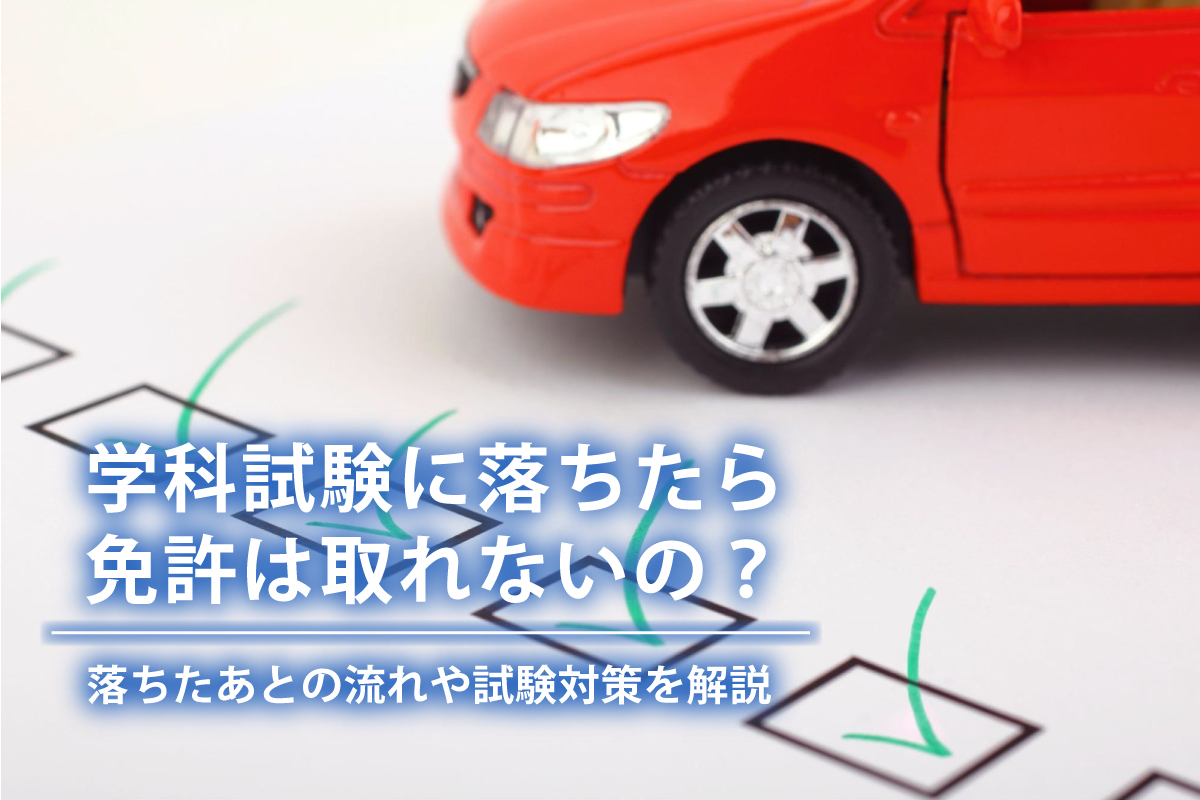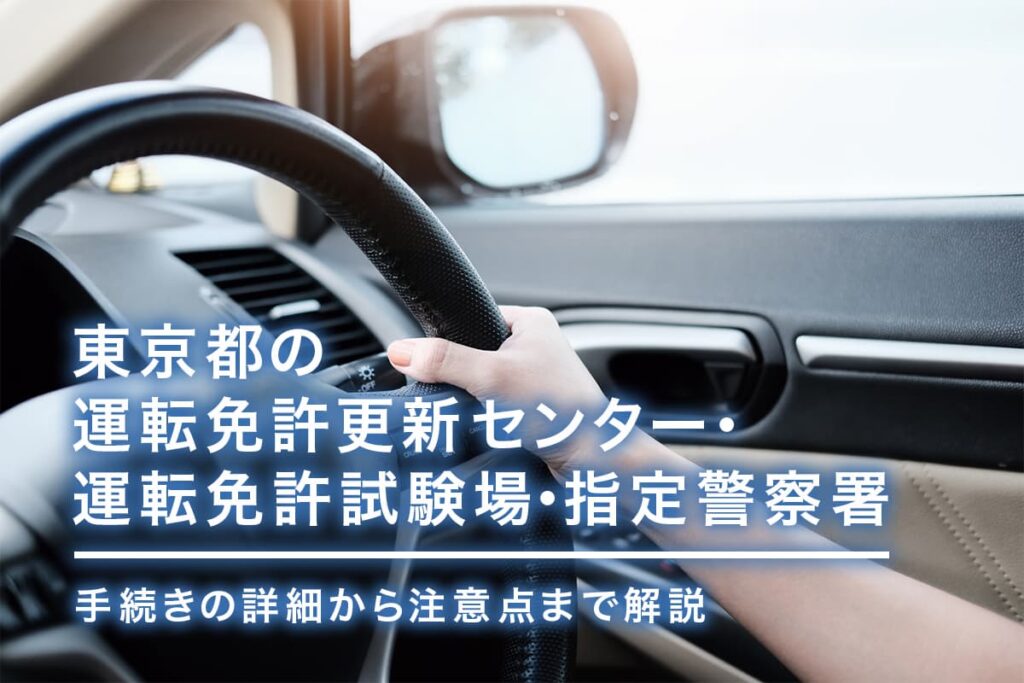According to the ``Driver's License Statistics 2021 Edition'' by the National Police Agency's Traffic Bureau Driver's License Division, the passing rate for the driver's license test in 2021 was 77.1%. The average pass rate over the past five years has been 76.3%.
| By year | Pass rate |
| 2017 | 75.7% |
| 2018 | 75.9% |
| 2019 | 75.1% |
| Reiwa 2 | 77.7% |
| Reiwa 3 | 77.1% |
While more than 75% of people pass the exam every year, about 25% fail. Some people who are about to take the written exam may be worried about what will happen if they fail.
First, let me tell you that even if you fail the written exam, you can take it as many times as you like. However, retaking the exam costs time and money, so aim to pass the exam on the first try. In this article, we will explain the key points to prepare for the exam for those who are anxious about the exam or those who failed the exam.
Process and costs when failing the written exam

It is desirable to pass the written exam on the first try, but unfortunately there are times when you fail. Even if you fail, you can retake the exam, so take measures to pass the exam next time. In the unlikely event that you fail the exam, it will be helpful to understand the process and costs for retaking the exam so you don't have to panic.
Here, we will explain the characteristics of people who are more likely to fail the academic exam, as well as the process and cost of retaking the exam.
Characteristics of people who fail the written exam
Some people who failed the written exam simply did not have enough time to study in the first place. However, despite studying hard, there are many people who fail the exam.
The characteristic of those who fail the exam is not simply a lack of study, but rather a major difference in whether or not they were familiar with the trends in the exam questions. The exam consists of 95 questions, 90 text questions and 5 illustration questions.
The score is 100 points, with 1 point per question for text questions and 2 points for each question with illustrations. The passing standard is 90 points or higher, so if you get 10 or more questions wrong in the text, you will fail the exam. Furthermore, the exam time is limited to 50 minutes, so each question must be completed within 1 minute.
Therefore, you must proceed with the problem accurately and with a sense of speed. By knowing the time limit for the number of questions in advance, you can avoid situations where you do not have enough time to reach a passing score.
In addition, the volume of the text questions is about 1-2 sentences, and the answer is either true or false. Text questions will be randomly selected from the following genres.
- Common considerations for pedestrians and drivers
- Things to know before driving a car
- How to drive a car
- Driving in dangerous places
- Driving on the highway
- How to drive a motorcycle
- In the event of a traffic accident, breakdown, disaster, etc.
- Things to know for car owners, users, safe driving managers, car driving agents, etc.
In order to drive a car after obtaining a license, you need to understand all of the above genres. However, there are also genres of content that are likely to be asked on exams. If you understand the question trends, you can focus on studying, so it is important to become familiar with the trends before the actual test.
In addition, we will explain in detail the genres that are most likely to be asked in the ``Tips for studying for written exams.''
When can I take the main license exam next?
Even if you fail the written exam, you can try again and again until you pass. However, even if the venue has an afternoon session, you will not be able to retake the exam on the same day. You can retake the exam on a weekday after the day after you failed.
For example, if you fail your exam on Friday, you can retake it the following Monday. The procedure for retaking the exam is as follows.
- Determining the test date
- Reception at the test venue on the day
- Payment of exam fee
- receive examination ticket
- Receive instructions on how to take the test and precautions at the venue.
- Academic exam begins
- Written exam finished
- result publication
The basic process is almost the same as the first time you took the test, but the aptitude test will be waived if you take the test again. In addition, for the exam, you will need a certificate of residence showing your permanent address and a graduation certificate from a driving school. If you fail the test, your residence card will be returned to you, so you do not need to obtain it again.
A driving school graduation certificate has a one-year validity period. Please note that if you do not pass the exam before the deadline expires, you will have to attend the driving school again.
Cost of retaking the exam
You can take the written exam as many times as you like until you pass, but each time you take it, you will be charged a fee. This is because a test fee is required each time you take the test. The amount may vary depending on the region, but in most cases it is 1,750 yen.
Also, depending on the region, there may be only one location where you can take the test. If the distance from your home to the venue is far, you will also need to pay transportation expenses each time you retake the exam.
Tips for studying for written exams

Here are some tips for studying for the academic exam. There are many trick questions on the written exam, so it is important to read the text carefully and not rush. Learn the study tips and aim to pass the exam.
Memorize the genres that are most likely to be asked
In academic exams, there are certain genres that are likely to be asked questions. The genres and examples that are particularly likely to be asked are as follows.
| Genre | example | answer |
| Contents related to expressways | The maximum speed of large freight vehicles on national highways is 80km/h. | 〇 |
| Basic sign display | Where there is a "Stop" sign, vehicles must stop immediately before the stop line. | × |
| car type | Those who have a Regular Motorcycle license can drive small special vehicles. | 〇 |
| Contents regarding overtaking/overtaking | When being overtaken, you can speed up more than the car behind you to avoid being overtaken. | × |
| About loading | Cars can be loaded up to 1/10th of the car's maximum carrying capacity without permission. | × |
| No parking allowed | Parking or stopping within 30 meters of an intersection is prohibited. | × |
A large freight vehicle is a vehicle with a gross weight of 11 tons or more. Microbuses and large buses are classified as large "passenger vehicles." For large lorries, the maximum speed on highways is 100km/h.
A "stop" sign means "you can stop", not a temporary stop. You can obtain a license for a small special vehicle without attending a driving school. If you have another license for a regular car or Regular Motorcycle, you can drive a small special vehicle.
Do not speed up when the vehicle behind you is trying to overtake. The upper limit of the loading capacity is determined for each type of vehicle, so it must not exceed even one-tenth. Parking is prohibited within 5 meters in front of an intersection.
Familiarize yourself with the problem of measuring effectiveness
At driving schools, a mock exam called an effect measurement is conducted before Karimenkyo Written Test exam. You cannot take the test for effect measurement until you complete the first stage of academic training. The questions asked include the basic knowledge necessary for driving, which will help you prepare for this driving license exam.
The effectiveness measurement is a multiple-choice format where you answer either 〇 or ×, which is the same question format as the main liberal arts exam. There are a total of 50 questions and a 30 minute time limit. If you take note of the questions you got wrong during the effectiveness measurement, you can expect to understand and overcome your weak areas.
In addition, in measuring effectiveness, there are many cases in which questions that are actually asked in the main liberal arts exam are used. You will be able to approach the exam with a similar feeling to the actual exam, so be sure to familiarize yourself with the question trends and wording of the questions.
Don't be fooled by trick questions
In academic exams, trick questions are asked at a certain frequency that can lead to misleading questions about the content of the questions. It is important to read the questions carefully to avoid being confused during the actual test. From here, we will introduce trick questions and answers that were actually asked in the past.
When to signal a change of course: “30m?” “3 seconds?”
A sample question is, ``If you want to change course while moving in the same direction, the time to signal is when you are 30 meters before you want to make the change.'' The answer is "x".
If you wish to change course while traveling in the same direction, you must notify us 3 seconds in advance. There is no rule that tells you when to change course based on the distance, so be careful not to make a mistake. The notification will be given 30 meters before the turn when turning right, turning left, or turning.
"Just before the traffic light" "Just before the intersection"
An example question is, "When there is no stop line at an intersection with traffic lights, the stopping position is just before the traffic light." The answer is "X."
The priority stopping location is the stop line, then the intersection. Therefore, if you are at an intersection with a signal and there is no stop line, you must stop just before the stop line. At intersections without stop lines, the stop position is immediately before the intersection even if there is a traffic light or stop sign.
Where do you measure the height of cargo that can be loaded?
An example problem is ``The limit for loading luggage onto the carrier of a motorcycle is within 2 meters from the loading device.'' The answer is "x".
Load height is measured in distance from the ground. The question states "within 2m from the loading device", which is incorrect. When it comes to problems like this, don't be fooled by just the numbers; pay close attention to where you are measuring.
Is it OK to use a horn as part of communication?
A sample question is, ``The car in front of me wouldn't start, so I sounded the horn to encourage it to start.'' The answer is "×".
The alarm must not be sounded indiscriminately. Sounding is permitted only in the following locations:
- Places where there are signs reminding you to sound the horn
- a place determined by law
- When it is unavoidable to avoid danger
The horn is not installed as a means of communication. Be sure to fully understand this and avoid using it inappropriately even after getting your driver's license.
Do I need to stop when an emergency vehicle approaches?
A sample question is: ``When an emergency vehicle approaches you at a location other than an intersection or its vicinity, you must move to the left side of the road and stop temporarily.'' The answer is ``x''.
When an emergency vehicle approaches you anywhere other than at or near an intersection, the correct answer is to pull over to the left and give way. However, at intersections or "nearby" locations, you must avoid the intersection and stop for a moment.
Points to avoid failing the written exam

Finally, I will explain the points to avoid failing the written exam. Even if you prepare well for the exam, there is a possibility that you will not be able to take the exam due to a mistake by the examinee. On the day of the exam, be sure to be prepared for everything other than the exam.
Make a list of what you need to bring and prepare in advance.
It is not guaranteed that you will be able to take the academic test just by attending during the reception hours. There are some things you will need to bring, so be sure to prepare them before the day of the event. The following items are required for the exam:
- Residence card with registered domicile listed
- Identity verification documents such as health insurance card
- ID photo used for Driver's License (if passed)
- Various certificates such as driving school graduation certificates
- exam fee
- Driver's License issuance fee (if passed)
- Driving license application form
- Residence card or special permanent resident certificate, etc. (if made in a foreign country)
- writing utensils
A certificate of residence showing your permanent address is required by the day of the test. You can obtain a residence card at your municipal office or convenience store issuance service. The fee varies depending on the city, ward, town, village and acquisition method, but it is around 350 yen per letter.
If you successfully pass the exam, you will be required to take an ID photo for Driver's License and pay a Driver's License issuance fee. In many cases, you can take photos at the venue, but if you want photos that you are satisfied with, you should prepare in advance.
Arrive at the test center with plenty of time to spare.
First, let's check the flow on the day of the exam.
- Reception at the test venue on the day
- Payment of exam fee
- aptitude test
- receive examination ticket
- Receive instructions on how to take the test and precautions at the venue.
- Academic exam begins
- Written exam finished
- result publication
- photo shoot
- Issuance of Driver's License
Reception hours vary depending on the venue, but most seem to be open from 8:30 to 9:00. On the day of the exam, traffic congestion and test-takers are expected to be crowded. If there are many applicants, the closing time of reception will be earlier.
There are several venues, so be sure to arrive with plenty of time on the day of the event.
Please note that there is an aptitude test before the written exam, and if you do not pass it in time, you will not be able to take the exam. There are a limited number of locations where you can take the exam, and depending on where you live, you may be far away. It is important to check transportation options and timetables in advance so that you can arrive smoothly.
Don't rush, read the question carefully before answering.
As explained in ``Tips for studying for written exams,'' the text questions for written exams include misleading sentences. If you rush, you may get the answer wrong, so be sure to read the questions calmly.
Contents that are easy to misread are as follows:
- Blue “light” signal, red “blinking” signal, yellow “arrow” signal
- "3 seconds ago" and "30 meters before"
- “Within 3m” and “Within 5m”
- “is” and “is not”
- “I can” and “I can’t” etc.
In addition, text questions may contain strong statements such as "must" or "absolutely." In such problems, the key point is whether or not there are exceptions. Examples of questions and answers are as follows.
| Example problem | answer |
| You must wear your seat belt at all times when driving a car. | × |
| While driving, you must always stop when passing a pedestrian. | × |
| Never brake suddenly while driving a car. | × |
It is compulsory to wear seat belts while driving, including those in the back seat. However, in some cases, such as when retreating or when pregnant women are exempt from wearing one. There is no need to stop when passing a pedestrian while driving.
The correct answer is to slow down or stop. If you want to avoid some kind of danger while driving, you are allowed to use sudden braking.
Preparation other than the exam is also important for written exams.

Even if you fail the written exam, you can take the exam as many times as you like as long as your graduation certificate is still valid. However, each time you take the exam, it takes time and money, so you want to aim to pass the exam on the first try. You can fully prepare for the exam by using past questions and measuring effectiveness.
Recently, online learning materials specializing in academic test preparation have also appeared, as shown below. Some of them are compatible with not only computers but also smartphones and tablets, so you can use your free time while commuting to work or school to prepare for exams.
Also, if you forget what you need on the day of the exam or are late, you may not be able to take the exam.
To pass the exam, you need to prepare for the exam, but you should also prepare for things other than the exam.








